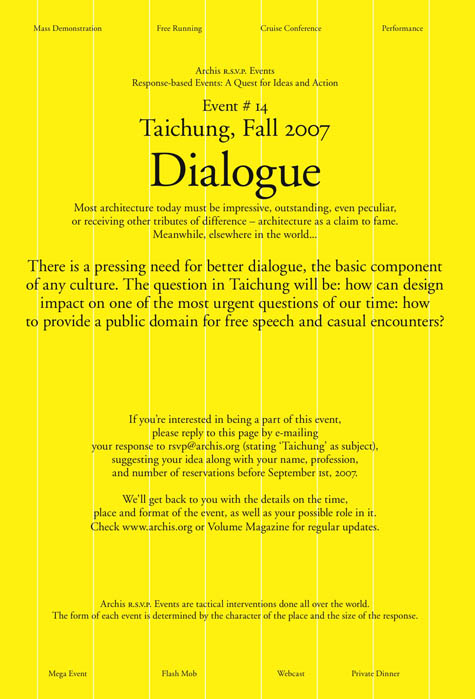I don’t want the recent Ole Bouman interview to get buried under new posts, so let me highlight a few brief moments in the interview that I particularly like, and then encourage you to go read it in full.
 For instance, Bouman says: “if you think that applying urban form is the same as building a city, or even creating urban culture, then you make a very big mistake.” He goes on to describe how “architecture culture” in the mid-1990s “was taken hostage by the politics of the spectacular.”
For instance, Bouman says: “if you think that applying urban form is the same as building a city, or even creating urban culture, then you make a very big mistake.” He goes on to describe how “architecture culture” in the mid-1990s “was taken hostage by the politics of the spectacular.”
Even today, though, he says, “nothing has changed. There is still an incredible focus – not just among architects, but among clients – on an architecture that is strongest at first sight. The second sight or the third sight is not so important anymore.”
In the process, “large congregations of architecture” have come to replace real cities – a kind of illegitimate spatial surrogate – and these are the hollow landscapes within which many of us now find ourselves living.
On the subject of post-conflict cities, then – or cities made hollow not by development but by war – Bouman says:
Very often all the discourse that is left to those people in post-conflict cities is about everyday needs, or maybe some rebuilding of political institutions; but culture is always at the end of the story, at the end of the line. What we can do is provide them with discourse, give them a certain vitality, as we did in Ramallah once, in Bosnia once, in Vilnius once – and even as we did at the feet of the Statue of Liberty once. If a city is in trouble, sometimes it’s good to organize dialogue, regardless of the subject matter – dialogue as a goal in itself.
Dialogue – and architecture, more broadly speaking – is thus about “reclaiming the public domain.”
That, of course, comes immediately after Bouman discusses China – which is perhaps my favorite part of the interview. There, Bouman says, and I’ll quote him at great length:
Bouman: It’s strange that China is seen as a new world by many Westerners, a land of opportunity, a place they all want to go… China is still seen as another world. You have to go there. You have to get yourself a portfolio in China. Or you have to start your office, or open a new headquarters there – so there is always the concept of over there, of otherness. I talk to Chinese colleagues, and Chinese businesspeople, and they sometimes openly admit that this persistence of otherness, this persistence of the idea that this is a country that is different from the West, that you can go to, or send your money to, is helping China to take over. To put it dramatically.
So, in terms of capital, for instance, if you just consider the fact that 15 years of boundless investment in China – hundreds of billions of dollars of investment in China, within a very Western paradigm of finding the best returns – is also, in the long-term, undermining the Western position. So, in a Western way of thinking, and from a capitalist point of view, investing in China may actually accomplish the opposite of what investors intended. These kind of paradoxes are hardly understood.
If China is launching a new rocket, or a new satellite, or testing a new space weapon system, suddenly people wake up – but there is this strange anomaly between China as the promised land and China as the latent rival, the opponent, the growing danger. Either people accept that China is becoming part of a larger global system of capital, and so they aren’t afraid to give it its own momentum wherever it goes, or whatever it takes – that is just the price you pay for growth. Or you say: we can no longer accept this – and this might be a moment that is not so far away anymore, a moment of regression or conservatism. Some governments will say that we can no longer go there, maybe, because we would not like to add to the power and culture of China. It’s still very fashionable to host Chinese festivals and to invite Chinese artists and to buy Chinese art – but the moment might not be so far away when we ask: why would we pay for China? If it reinforces or strengthens their power?
I feel sometimes that we are just a little bit away from the moment when this paradox, this anomaly, will erupt into a more existential question. What do we do? Do we keep adding to the strength of China? Or do we go back to this kind of Western chauvinism, or nationalism, and not allow architects, for instance, to work in China or to allow Western investors to invest in China?
I think, in the work of Rem Koolhaas, for instance, this anomaly is almost already on the surface. On the one hand there’s this admiration of the great architect with an incredible track record who goes to build in China, who creates a new monument, a kind of signal of what architecture can do, an incredible achievement. On the other hand, there is this latent, almost open criticism: what does this do for China? Are we giving away our assets to the enemy? I think in the whole discussion around the CCTV Building you see this tension between chauvinism and internationalism, between western interests and the interests of globalization in general, and many other dialectics in the debate being played out through that specific building. That’s why the building is so interesting. As a metaphor, it represents much more than just the fact that it is built for an institution of Chinese power by a powerful western architect; it also reveals something that has to do with the dynamics of our culture – and where architecture can do that, then architecture is gaining in legitimacy.
 [Image: Ole Bouman, photographed by Cassander Eeftinck Schattenkerk].
[Image: Ole Bouman, photographed by Cassander Eeftinck Schattenkerk].
In any case, if you get a chance, check out the rest of the interview.